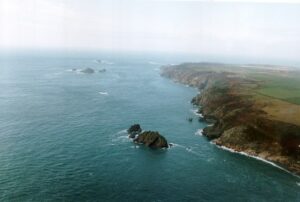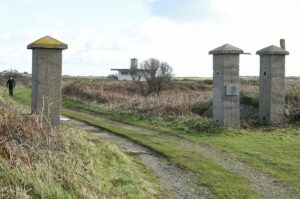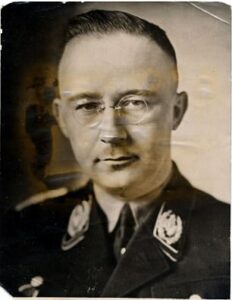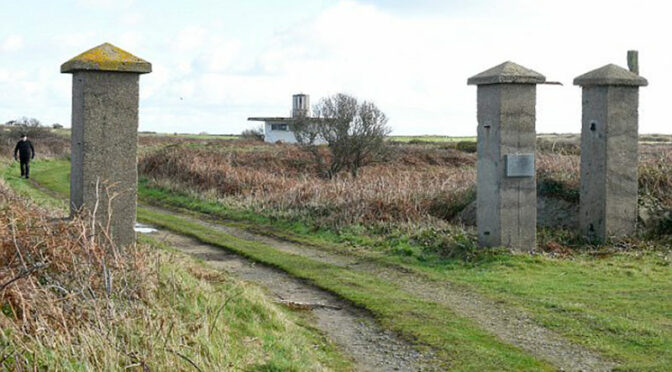Article published in The Daily Mail, Monday 8 May 2017.
Part two of RICHARD KEMP and JOHN WEIGOLD’s account of how the Nazis turned Alderney into a secret base to fire V1 missiles with chemical warheads at Britain’s south coast. Here, they reveal how tens of thousands of slave workers died to fulfil Hitler’s evil plan.
The inmates of the slave labour camp lived their pitiful and short lives in constant fear.
One who against the odds survived recalled being marched to work and a fellow prisoner falling to his knees, unable to walk further.
‘The Germans shot him right there,’ he said. ‘Another man was crucified for stealing, hung by his hands. When I got up in the mornings I saw dead bodies in the bunks around me. Sometimes their lips, nose and ears had been eaten by rats.
‘There was a special hut where the corpses were piled. Later, they were taken away, loaded onto trucks and dumped in the sea.
‘We were fed just water with a few bits of turnip floating in it, so life was a constant struggle for food. I found a rubbish heap near to the construction site where I worked and was filling a bag with vegetable peelings and cabbage leaves when someone set a dog on me.
‘It attacked again and again, tearing all my clothing. When it let go, I was beaten with a stick by a German. I was very weak at the time. There were about 500 men in my camp, and at least 300 died while I was there.’
In all its gruesome detail, this recollection of the struggle to survive under the Nazis makes the blood run cold. What is even more chilling, though, is that the camp was not in some far-flung corner of the Third Reich.

It was here on British soil. On the tiny Channel Island of Alderney.
Which Nazi garrison was the last to surrender at the end of World War II? The somewhat surprising answer to this pub-quiz-type question is Alderney, 60 miles from the coast of England. Its occupation force waited until May 16, 1945, before laying down their arms — nine days after the official end of the war.
Why did they hold out for so long? We suspect because they had records to destroy, secrets to conceal and cover stories to concoct for all their nefarious activities in the five years they held the island as a military stronghold far away from prying eyes.
In Saturday’s Mail, we revealed one of those secrets, hidden for 75 years — that the Germans built a concealed V1 missile site there with the specific deadly aim to rain down outlawed chemical bombs on the English coast and disrupt D-Day preparations.
That site included a complex of tunnels in which to store the missiles — hewn out of the bare rock by a slave labour force of concentration camp inmates. Slave labourers also constructed the vast array of fortifications, bunkers, casements and defensive walls that made mysterious Alderney one of the most heavily fortified outposts of the Third Reich.
Yet there were few local eyewitnesses to the horrors and inhumanity that went on for five years. This was because though the island was (and is) part of Britain, all but a handful of its inhabitants were evacuated to the mainland just before the Germans invaded in the summer of 1940.
Unlike the bigger Channel Islands of Jersey and Guernsey, where most of the population remained and lived through the Nazi occupation, the five-and-a-half square miles of tiny Alderney were a cut-off German enclave.
They had a free hand to do what they wanted there without fear of surveillance or interference. And they exploited that freedom without restraint.
Over the next five years, Organisation Todt, the monolithic enterprise that ran Nazi construction projects, hired some voluntary labour from Germany and France but mainly shipped in slaves — thousands upon thousands of Russian prisoners of war and forced labourers, men and boys dragged from their villages in Russia and Eastern Europe, Jews from France, French and Spanish PoWs and even captives from Morocco.
These slave labourers made up at least three-quarters of the work force on the island.
With them, as elsewhere in the Third Reich, the Germans embarked on an orgy of beatings, torture, starvation, recreational killing, crucifixion and systematic mass murder.

They were housed in appalling conditions in slave labour camps. The existence of four of these — named Norderney, Sylt, Borkum and Helgoland, after German islands — is well known.
But we have identified a further seven subsidiary camps on the island, most within sight of what are now sun-kissed sandy tourist beaches. Aerial photography pinpoints suspected mass graves and burial pits.
No wonder that, in hushed tones, a female French volunteer worker who lived on Alderney with the Nazis spoke of it as ‘the island of terror, nightmares and silence’.
The silence was because all the seabirds that once thronged its cliffs and skies had gone — they’d either flown away or been caught by starving inmates and eaten.
So when the Germans finally surrendered, it might have been imagined that a full war crimes investigation would be mounted. Instead, Britain’s military intelligence service, MI-19, sent in an earnest but inexperienced young officer, Captain ‘Bunny’ Pantcheff, to interrogate the Germans.
In the few weeks he had to do his job, he claimed he debriefed hundreds of the former occupiers, though, given the time available, the interviews must have been pretty peremptory. He came to the conclusion that there had indeed been serious mistreatment of prisoners and labourers on Alderney. Many had died from over-work and harsh treatment.
He heard accounts of prisoners in the island’s SS-run Sylt concentration camp being hanged together on a triple gallows, and how others were tied to the barbed wire gates and flogged.
He counted the graves on the island as best he could, largely from just one particular and obvious site, and estimated the total tally of dead at around 400.
To the authorities he reported to in London, it must have seemed a drop in the ocean compared with the mass murder and genocide being revealed in other parts of Europe, where the Holocaust had claimed millions of lives in scores of Nazi labour, concentration and extermination camps.
Pantcheff’s superiors — anxious to begin reconstruction in the fraught post-war world, as well as embarrassed that this piece of British territory could have been a place of Nazi slaughter — were glad to accept his findings, ignore his recommendation that at least one German officer should be charged with war crimes, and file away his report.
It later went missing and was said to have been destroyed.
In December 1945, the islanders were allowed to return. Not surprisingly, they did not ask too many questions about what had happened in their absence.
They didn’t want to encourage its ‘Death Island’ reputation, and, in those difficult post-war years of re-building lives and livelihoods, who can blame them?
But the plain, unpalatable fact is that the terrible, blood-soaked truth of what really went on was suppressed for political convenience, swept under the carpet and forgotten.
As the years went by, what amounted to a cover-up continued. Pantcheff himself settled on Alderney and wrote a book that perpetuated the myth of a relatively benign occupation there, along the same lines as Guernsey and Jersey, where islanders and occupiers managed to live side by side in reasonable harmony.
In the absence of any public information, this book became accepted as the ‘official history’.
The trouble is that — to our seasoned military minds, having between us 45 years of Army experience — Pantcheff’s figures are pure hokum.
We know about interrogation, and how prisoners will lie to save their skins. The Germans he quizzed gave him a highly sanitised and rehearsed version of what had actually taken place. The reality they concealed was infinitely worse. He was hoodwinked.
We also know about military construction, terrain and logistics, and that the figure he gave for the number of slave labourers on the island — 4,000 at most — is also hokum. It’s a serious under-estimate that has perpetuated an historic lie.
The sheer volume of fortifications, walls and tunnels outstrips anything else in Hitler’s Third Reich. This huge amount of work could not possibly have been done with just 4,000 workers.
We estimate it would have taken that number alone just to pour the 86,000 cubic metres of concrete used to make Alderney impregnable.
There would have to be thousands more to dig pits into the rock, build wooden moulds for the concrete, lay wire, work in the quarry, make roads, dig cable trenches, excavate tunnels, unload ships etc.
Equipped with primitive tools (and often no tools at all, just hands and feet), at least 10,000 workers would have to be labouring away at any one time to complete all this work. And that is supposing they were fit and strong. But these labourers were starved and weak.
They were being worked to death as a matter of policy — a factor that until now has not been taken into consideration in compiling Alderney’s war-time history and assessing the number of victims who worked and died there.
The Nazi regime regarded PoWs and slave labourers from Russia, Ukraine, Poland and elsewhere in eastern Europe as they did the Jews — as untermenschen, sub-humans.
Under an ‘Extermination by Labour’ order issued by Heinrich Himmler, head of the SS, in March 1942, they were to be worked hard, mercilessly beaten, fed on starvation diets, killed out of hand for minor infringements and driven on, often diseased, until they died.
This was part of Hitler’s long-term overall plan to depopulate vast areas of Russia and Eastern Europe to provide living space for ethnic Germans. It required the genocide of 35 million people.
Those who give minimalist numbers for the deaths on Alderney argue that the slave labourers were shipped off the island and repatriated after their job was done. But not only is there no evidence of significant numbers being returned home, for the Germans to have done this defies logic.
There was never any intention to return civilian or military prisoners taken from the east. Once captured, they were effectively under sentence of death.
They died not in hundreds but in their thousands and tens of thousands on Alderney. And when they dropped, they were replaced by others — who in turn were also worked to death and then replaced.
With an average life expectancy of just three months, turnover was rapid. The numbers mounted ever higher, multiplying constantly in the grim mathematics of mass murder.
The odds of survival were slim. In the camps, breakfast was black coffee only, lunch a bowl of watery vegetable soup. At night they had another bowl of the soup, plus 200g of bread.

On this starvation diet they worked 12 hours a day, seven days a week on back-breaking manual work, digging, smashing rocks, lifting and carrying heavy loads. They were whipped to work harder and faster and beaten with sand-filled rubber hosing and the handles of pickaxes when they faltered.
According to a survivor, Nicolas Virijnikov, his fellow Russian slave labourers held out reasonably well for the first two months, but then ‘started to die one after the other’.
At night, up to 270 men were jammed into each filthy, rat-infested hut, breeding grounds for debilitating diseases.
During the day, with no protective clothing and their feet often bound in rags rather than shoes or boots, they were prone to injury. Feet were crushed, limbs broken, heads smashed, backs strained, eyes put out.
With no proper medical facilities, those unfit to work were dealt with under a Nazi prisoner euthanasia law, also enacted by Himmler, which allowed them to be liquidated. Another survivor, Wilhelm Wernegau, confirmed that ‘when people could no longer work, there was only one thing that happened to them. The SS would kill them.’
A special squad was deployed for this purpose, known cynically as the ‘Himmel [Heaven] Kommando’. It was run by SS Sergeant Krilman, one of whose preferred methods was to inject prisoners with benzene, a cheap and efficient means of mass killing well known to the Nazis.
Chilling details like this we know from the witness statements of survivors, mainly Russians, that have emerged in the years since Pantcheff’s semi-official history was published, showing just how horrendous conditions really were. One describes the construction of an observation post at Fort Albert, a massive and forbidding Victorian fort overlooking Braye Beach. ‘Two prisoners collapsed where they stood, and to my horror they were thrown into the sea. Later that day, seven more went the same way. Throwing men over the cliff became the standard way of getting rid of exhausted workers.’
On another occasion, he saw 50 slave workers shot and thrown into the sea with stones tied to their feet. ‘This mass murder system was repeated seven times before the observation post was finished.’
A Spanish prisoner sent down into the waters of the bay in a diving suit to free a snarled-up anti-submarine boom was sickened to see the seabed covered with countless bodies and skeletons, and crabs and lobsters feeding on them.
The biggest labour camp — Norderney — was behind the sand dunes of Saye beach. At one point, among the thousands crammed into its huts of three-tier bunks were 400 French Jews, who were placed in a separate barbed-wire compound.
Many were elderly but still had to work and died from exhaustion or beatings. They were starved and laughing Germans would taunt them by throwing pieces of carrot into the compound just to watch the poor wretches fight over them.
There was a short tunnel near the camp and the prisoners were told that, in the event of an Allied invasion, they would all be herded in there at gunpoint and the ends sealed off to leave them to suffocate and die. But even more brutally run was Sylt. Originally a labour camp for the military construction programme of Organisation Todt, it was taken over by the SS in March 1943 and re-designated as a concentration camp. Its true purpose remains shrouded in mystery.
It was camouflaged from the air, guarded by its own anti-aircraft guns and was the centre-point of the SS operations on Alderney, which included the V1 missiles with chemical warheads being developed there.
We can only speculate what other long-term plans the SS — which had a particular interest in secret weapons programmes — had for sinister Sylt.
Its remains are still clear in the undergrowth in the south of the island. There are gateposts and concrete sentry posts, plus outlines of kennels for the savage dogs let loose in the compound at night to make sure the prisoners stayed in their huts.
You can count the pitifully small number of latrine holes — just 14 for a camp of thousands — and walk through the tunnel in the surrounding embankment wall to the brothel built outside for the amusement of the SS.
The regime there was ruthless. A British intelligence report speaks of a Russian being crucified on the camp gate, naked and in midwinter. ‘The guards threw buckets of cold water over him all night until he was dead.
‘Another was caught by bloodhounds when attempting to escape. He was hanged, then crucified on the same gate and his body left hanging for five days as a warning.’
A survivor recalled 500 men dying there during his time alone — ‘from being murdered, from hard work, from starvation and the climate. Some were beaten to death and many more were strangled.’ More arrived from concentration camps in Germany such as Buchenwald, Sachsenhausen and Neuengamme to take their place.
Everywhere you look on Alderney, the past horrors mount up until the conclusion is inescapable. The idea of just 4,000 slave workers on Alderney and a total of 400 deaths is nonsense. It simply does not add up or fit the facts.
Consider the kilometre of tunnel scoured out of bare rock to house the V1 missiles, and completed in just ten months. That must have taken a colossal work force of many thousands.
We had long suspected that the death toll on the island was considerably more than had ever been recognised. Our discovery of the missile site and the labour-intensive work to construct it clinched the argument.
To arrive at precise figures of the numbers who worked and died on Alderney during World War II will never be possible. Ball-park is all we can hope for. But we know with certainty the ball-park is vastly bigger than has ever been suggested before.
We are confident in estimating that in the peak Organisation Todt construction period between January 1942 and October 1943, a minimum of 40,000 slave labourers died from exhaustion, sickness, injury and brutality, and perhaps as many as 70,000.
The SS also had their own labour force employed on secret tasks from March 1943 to June 1944, most of whom would have been routinely executed on completing their work. Thus the body count may be even higher.
But where, our critics will ask, are the remains? Where did the bodies go? The answer is that many were lost in the sea and carried away by the tide. A known practice of the guards was to bury the dead in the shallow sand at the lowest tide and let the sea wash over them.
Many were probably cremated. Others were heaped into unmarked mass graves — piled-up corpses take up much less space than people might think. And still more were tossed into the foundations of the concrete structures they were building on the island and covered up. All this makes Alderney the scene of a massive war crime, its own mini-Holocaust, no less. And one — as we have to keep reminding ourselves — that was on British soil, in our own front garden, as it were.
It is time this was finally recognised. The island is also a mass grave, which needs to be respected.
Britain is currently building a memorial to the Holocaust near the Houses of Parliament in London, intended for completion by the end of the year.
We believe a memorial should also be constructed on Alderney, in belated recognition of the thousands of slave labourers who were undoubtedly murdered on the island. We have a moral duty to acknowledge their lives and their suffering for the sake of their memory and for all those relatives and loved ones who never knew where they had met their fate.
It would be a place for education and reflection where future generations could honour the dead, admire their courage and learn about the horrors that result from unchecked totalitarianism.
Alderney has a unique history that we believe would qualify it as a world heritage site, to be preserved at all costs. All around, you can still find evidence of the lives and deaths of those thousands of victims of Nazi brutality and mass murder.
Bullet holes in walls where they were shot by firing squads; their footprints and names inscribed in wet cement; the remains of the camps in which they lived and suffered; the monstrosities they were forced to build and where many are probably buried; the mass graves.
All bear sad testament to their passing. For them, Alderney is hallowed ground that needs preserving. A reminder of man’s inhumanity to man — one that, in our own troubled world, we perhaps need more than ever.
© Richard Kemp and John Weigold. Col Kemp is a former commander of British Forces in Afghanistan. John Weigold was an Army officer who served in the Gulf and Northern Ireland.

